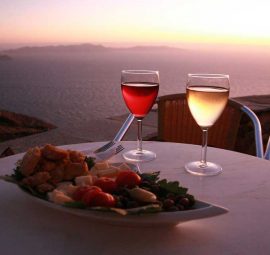The island of flourishing vineyards, authentic beauty & traditional lifestyle
While just a breath away from Ios and Santorini, Sikinos is really worlds away from its cosmopolitan neighbors and the touristic radar. An off the beaten track gem with the most charming villages, pristine sceneries, traditional customs and authentic people, where you can experience traditional island life away from annoying crowds. Sikinos’ enchanting atmosphere will make you appreciate the simple moments in life. You will enjoy the stunning view from the terraced Chora, swim in the crystal clear waters, wander around the graphic alleys, mingle with the locals and listen about the island’s rich history. Sikinos shines bright in its simplicity and promises a gentler way of life.HightLights
- Church of Episkopi: is the most famous monument of Sikinos located near the ruins of the ancient city of Sikinos. In the area you will find the Temple of Episkopi which was constructed in the 3rd century AD as a Roman burial monument, later became the temple of Apollo Pythons and finally modified to an Orthodox Christian church dedicated to the Domitian of the Virgin. Right next to it you will find a Byzantine chapel of St. Anne.
- Church of Panagia Pantanassa: is a beautiful blue dome church constructed in 1787 and located on the square of Chora. Inside you will find some remarkable icons which belong to the Cretan School.
- Folklore Museum: is housed in Chorio, inside an olive oil press that used to be the family house of an American expatriate who served the US Navy. The museum exhibits a collection of artifacts and materials used in the island through the course of its history.
- Manalis Winery: is open for visitors who wish to taste the islands exquisite wine, discover the traditional way of production and take a tour on its 20 acre vineyard. Sikinos is known since the ancient times for its fine wine varieties. In fact the island was once known as Oinoe (the island of wine). Manalis is situated on the northwestern side of the island and offers beautiful panoramic views of the Aegean sea and the neighboring Cyclades islands.
- Panagia Pantohara: is one of the most impressive chapels in the island, situated between Kastro and the monastery of Zoodohos Pigi. The construction of this church was the dying wish of Odysseus Elytis, one of the most notable poets of Greece and a price winner. The church was built in his honor after his death by his wife Ioulita Iliopoulou and was dedicated to the Virgin Mary of Pantohara. From there you will enjoy one of the most outstanding views in Sikinos, an island which the poet used to describe in his works.
- Sikinos Byzantine Museum: is located at the southwest edge of Kastro (Paraporti) in Chora. The museum holds a collection of icons from the Post-Byzantine era as a collection of photographs of the island’s byzantine churches.
- The Archeological site of Agia Marina: it preserves ruins from the ancient city of Sikinos that date back to the Hellenistic and Roman period. The more evident ones are the ruins of strong defensive enclosure, buildings and churches. The site is located on the hill of Agia Marina and can be accessed by foot through a hike trail that begins from the monastery of Episkopi. The hill offers amazing view of the surrounding islands.
- The Archeological Site of Paleokastro: has extended ruins of an ancient settlement dating back to the pre-historic era.It is believed that the town of Oenoe was located in the area. The site is situated above the beach of Maltas and can be only accessed though a hiking trail from the beach.
- The Black cave: is an impressive cave located below the cliff that hosts monastery of Zoodohos Pigi. Despite its small depth is one of the biggest and more imposing caves in the Cyclades.
- The monastery of Zoodochos Pigis: is a female monastery, on top of a cliff northeast from Chora, offering a panoramic sunset view. It was built around 1690 as a nunnery butstoppedoperating in 1834 on King’s order. The monastery was used as a fortress by Sikinos people to hide from pirate invasions. Today is renovated and host a folk museum where everyday objects from the nunnery are exhibited.
Towns & Villages
Chora
Chora is the capital of Sikinos and is divided into two sections. The Kastro (castle) on the west, and Chorio (village) on the east. Kastro is a fortified settlement that was created in the 15thcentury under the Venetian rule. Its walls are right on the edge of a cliff and give magnificent views to the rest of Sikinos and the sea. Today there is only one remaining part of the castle called Paraporti. Kastro is typically the center of Chora, with authentic tavernas, traditional kafenia (cafés) and a few shops. However, most of the settlement remains unspoiled with interesting byzantine churches and museums. Chorio is located 100m to the east of Kastro. It is a beautiful and slightly more developed settlement with labyrinth streets, narrow passages and stone built houses. Chora is considered one of the most authentic towns of Cyclades that will travel you back in a bygone age.
Alopronia
Alopronia is the port of the Sikinos and the center of touristic activities in the island. It offers various accommodations, moderate entertainment options, including tavernas with live music, cafes and bars, and a nice organized beach. This small picturesque fishing village is a very nice place to spend day and night.
Beaches
- Agios Georgios: is the most famous beach in Sikinos and the favorite spot of the locals. It is a large sandy and pebble beach with crystal waters and trees for natural shade, on the eastern part of Sikinos. The beach is not organized and is ideal for those looking for relaxation and tranquility. Close by there is a taverna. Agios Georgios is accessible by car and by boat.
- Agios Panteleimonas: is a small sandy bay with blue waters on the eastern coast on the island. The beach has a small cave that offers natural shade and is ideal for those who seek seclusion. Agios Panteleimonas can be accessed by boat or by a path from the port.
- Dialiskari: is a small cove near the port of Alopronoia with transparent blue waters. Dialiskari’s sandy beach is covered with few trees and umbrellas for relaxing moments by the sea, as well as rocky surroundings where you can sunbathe. The beach can be accessed by following a small dirt road or by boat.
- Livadi: is the beach of the harbor of Alopronia. It is a long sandy beach, organized with various amenities including umbrellas, sun beds, beach bars and tavernas. Its calm blue waters are welcoming to families and those who are looking for a tranquil atmosphere.
- Malta: is a secluded beach on the northern side of the island. This white sandy and pebble beach with azure waters attracts those looking for isolation and relaxation. The beach is completely unorganized and fully exposed to the sun. Access to Malta is done by boat or through a long path from Kastro.
- Santorineika: are two small pebbled bays with transparent emerald waters on the southern part of Sikinos. Santorineika are very popular among adventure lovers who seek diversified landscapes, due to their rocky landscape and seabed. The beaches are accessible by boat or by a long hiking trail.
History & Mythology
Mythology
In ancient years the island was known as Oinoe, which derives from the word "oinos", meaning wine in Greek, because of its flourishing vineyards. According to mythology, Sikinos was given its current name from the son of King Thoas of Limnos. Thoas had to leave Limons because local women had started a revolution and killed all the males of the island. Thoas managed to escape with the help of his daughter, who hide him in a large jar and threw him in the sea. Thoas was drifted all the way to Oinoe. There he met a nymph and had a son, Sikinos. The island is known as Sikinos every since.
Sikinos History
Ionian rule: Ioanians were the first to occupy the island in the 10th century BC
Dorian rule: Dorians arrived atthe island in the 5th century BC.
Roman, Byzantine, Venetian and Turkish rule: Sikinos’s history was parallel to the other islands of the Cyclades, passing from Roman to Byzantine ruleand then falling to the Venetians (part of the Duchy of Naxos) and the Turks (1537). The island also experienced numerous pirate invasions.
Greek State: the island became part of the Greek state on 1830, after actively participating in the Greek revolution of 1821.
Ioannis Metaxas Dictatorship: communists and socialist were deported to the Cyclades during the period of 1936-1940 and Sikinos bore the brunt of the refugees. Refugees outnumbered the local inhabitants.
Italian and German occupation: the island fell under the Italians and Germans during the Second World War.
Gastronomy & Local Specialties
Exquisite local products and must dishes of Sikinos include:
- Diagkourenia: porridge of watermelon juice and pastry with honey and sesame seeds on top
- Excellent local wine, cultivated in the island for many centuries
- Figs
- Greek salad with locally produced capers
- Local kebab meat
- Olives
- Pasteli: soft bar made out of sesame and honey
- Pourazenes: a type of dolma wrapped in leaves
- Raki: alcohol drink similar to tsipouro
- Rooster in wine and red sauce and spaghetti
- Sikinos honey known for its intense aroma and sweet taste and vibrant color
- Stuffed goat, lamb or rabbit baked in the oven with potatoes
- Thyme
- Traditional pies with sweet local cream and ricotta, or onion and sour milk
Events & Festivals
Religious Festivals
- Panigirades: is a traditional religious custom greatly widespread in Sikinos. Panigirades are inhabitants who are chosen to host for a year in their houses islands’ holy icons and honor it daily by keeping their holy candles burning day and night. The day that the saint of the icon is being celebrated, Panigirades are organizing a big feast at the end of which they pass the holy icon to the next “panigiras” according to the waiting list. To be a “panigiras” is considered a great honor in Greece. In Sikinos there four holy icons hosted in houses, Panagia Pantanassa, Holy Cross, Zoodochos Pigis and Isodia. There festivals are celebrated in the following dates:
- Panagia Pantanassa on the first Friday of the Great Lent
- Zoodochos Pigi on Good Friday
- Holy Cross on September 14th
- Ιsodia of Theotokos, November 21st
- Other Important Festivals of Sikinos: are celebrated at the churches of the island, inviting all visitors to participate in the various customs and traditions and have fun. The most important ones held on the island, mostly in Chora, are:
- Agioi Anargyroi on July 1st
- Profitis Ilias on July 20th
- Agios Panteleimonas on July 27th
- Virgin Mary on August 15th and September 9th
Cultural Events
- Documentary Days: is an open–air film festival that that takes place every summer in Sikinos and Folegandros islands.
- Sikinos Festivities: are organized every summer to promote local culture to both locals and visitors through, exhibitions, performances and concerts.
- Summer Festival of Sikinos: takes place every August on the island and held’s various cultural and musical events.





